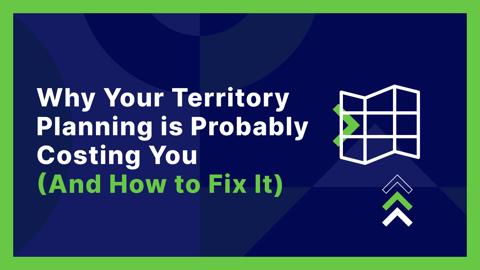If you had to reduce the handbook of being a better sales executive to just a handful of terms, both sales territory and quota planning would remain embedded as two of the golden threads that make the sales world flourish when implemented correctly. Popular products, marketing techniques, and consumer trends may come and go, but that pair of pillars holding up all of these “sales outcomes” remains rock solid. Or do they?
Okay, the point of what you’re about to read is not to challenge that or even create doubt, but to provide a definition, context, and value to both sales’ territory and quota planning. We’ll break down each into what are the important metrics and insight to gain from these tools, and how the right software platforms not only remove the guesswork from setting territories and quotas but make for a smoother and more lucrative pathway through your sales pipeline. So, if you want to reinforce your most pivotal sales pillars (which we’re guessing you absolutely do), read on.
What are Sales Quotas and Sales Territories?
If this short recap feels a bit like “Sales Room 101”, we make no apologies, as a clear definition lays the foundations for everything else. And as we’ll discover, the two are very much reliant on the other for success.
Sales Quotas are set by sales managers and are the target that an individual or team must hit within a set time, such as a month, quarter, or year. The quota may be based on the number of customers secured, products sold, revenue raised, or all of these, but this will likely be within a territory (see, we weren’t kidding when we said these two were linked).
There are several purposes for setting sales quotas, including forecasting, and determining sales goals ahead of a sales or financial period. By doing this, managers stay abreast of sales metrics and can accurately measure success. This then informs any reporting that needs to be done to higher management and stakeholders.
Setting sales quotas is also essential for sales executives to do their job well. On being given a new quota, a sales executive knows how much they need to do, and is motivated further as quota fulfillment equates to earning their incentive compensation management (ICM) payment. The tricky bit (which is where sales quota software becomes invaluable), is getting the balance right between a well-received challenge versus an impossible feat requiring superhuman powers to reach.
Shortly, we’ll take a deeper and look at the different types of sales quotas (revenue, profit, volume, forecast), the art of quota planning, plus when and how to apply each to the right circumstance. We’ll also cover what metrics to look for when using supporting software. But first, here are the basics about sales territories.
A sales territory is the region, industry, or group of accounts assigned to an individual or team that then influences the size of their sales quota. This is where it does get a bit “chicken and egg” and more difficult to separate out. Just to add further nuance, depending on the size of your sales division, any given “region” may vary from a small town to an entire continent; or it could be you have one major account given to a team for a super-big client, while another team is working across several hundred smaller accounts and customers.
The underlying and critical factor is that if you’re the person responsible for setting territories, you understand them, top to bottom. That means being all over competitor presence, understanding every issue and possible advantage that goes with entering a new territory, and being the first to realize and act if a territory is over or under-resourced with sales executives or product.
Back in the day, (when life was lived in black and white, and a successful sale was noted in a ledger book) sales territories were set by sticking pins in a map, and quotas could expand and shrink depending on the mood of the manager. These reactive tactics are, thank goodness, no longer acceptable and rarely practiced. As with sales quotas, there are several factors and variants when assessing how to set a sales territory. These include defining your market, plus assessing account quality, territory quality, and the skills of the sales reps that will be assigned there.
A Quick Side-note on Sales Goals
Just ahead of our full immersion into sales quota and sales territory planning, it’s worth calling out why a sales goal is a different metric and topic. A sales goal is the wider objective and the subject of many of our other blogs and articles. It can be projected sales revenue for a year for everything, or what you hope to earn in one quarter for a single product. Sales quota and territory planning are two of the methods by which you reach that endpoint.
Implementing a Great Sales Quota Planning Platform
The most fundamental step when implementing a sales quota platform is knowing what your metrics are and what analytics you’re looking for. Our top six are as follows:
1. Revenue Quotas
It’s as simple as the name suggests. A sales executive is required to sell a certain amount of product or solution across a set amount of time (and within a designated sales territory). While this could be set for as short a time as a week or month, given that the average sales pipeline cycle is longer, then so should the expectation be for reaching quota fulfillment. The metric for success is simply a monetary one – how much has been made against what was asked for.
2. Profit Quotas
Not so different from revenue, but with one big difference; Gross profit takes away the cost of goods from that revenue number, which gives a more accurate picture of how much money has finally been earned from any given sale. This means that when you’re setting quotas, it’s as much about the overall value of a customer, or leads, rather than the amount of product shifted. This is where software performance management tools for quota planning can really add value, as a good one will be able to provide detailed “scenario” reporting on potential customer value versus simple leader-board revenue figures.
3. Activity Quotas
We’re now getting into what could be labeled, the “grit in the oyster”. Activity quotas set the tasks for an individual or team, and how long they must get these done. Rather than simply tell a team to go away and make money, this is how many phone calls or emails are required, or how many product demos are booked. The possible “grit” is that it’s a quota setting or parameter that can not only highlight the high achievers but can expose those that may be struggling or coasting. The results could on the one hand contribute to someone qualifying for a healthy commission, but on the other, may lead to a performance management review. Whichever way you look at it, this reporting and planning reveal far more than a simple revenue metric.
4. Volume Quotas
This element of sales quota planning shifts the focus from profit to the amount of a product or solutions sold within the time frame, and the metric is how close they got to completion. When looked at objectively, it can seem to be a complete contradiction of all the previous quotas, relying as it does on a volume, rather than value or activity. That’s why it’s usually applied to certain sectors and products where there is a similar monetary value, and the emphasis is on numbers rather than value. It’s also more of a short-term sales strategy, often implemented in a sale or to offload a product about to be discontinued.
Want to know more about setting and achieving manageable sales quotas? This article will set you on the way to that goal.
5. Forecast Quotas
This is the sales quota planning method that analyzes past events, data, and insight to create a quota for the future. For example, if a certain amount of revenue was made by a team in a specific territory last year, this will be the expectation baseline for the same period in the year ahead. But maybe a 10 percent profit will be required. Or if there have been some specific economic conditions, that quota may be lowered. There is an amount of science and technology that goes into this and all the other methods which remove the guesswork and keep these as credible ways of setting up your quotas, which is why we recommend that you get on board with a robust sales quota software platform like the one we offer at Varicent, plus our intuitive Symon AI tool that allows you to fully utilize your data and plan around it to mitigate all eventualities and outcomes.
6. Combination Quotas
It’s quite common to apply more than one quota method or combine them. This enables a team or sales executive to achieve targets through a blend of revenue or monetary targets as well as activities. The final quota attainment calculation may be an average number across the different quotas, or for each one separately. If you’re using sales quota software for your planning, you can set the rules and customize the fields, but a combination approach also helps those in your team manage their time and targets more efficiently.
Discover further great tips on setting up and managing your quotas here.
Setting Your Sales Quota Territories
You read in the above how often territories play a part in setting sales quotas, and there are also overlaps when laying down the cardinal rules of territory management.
1. Defining Your Market
This is the scene-setter for all of your sales territory tactics. Without understanding your market, there’s a strong possibility all your territory decisions will be incorrect. You need to be sure of the geographical area you’re going after, who are the potential customers within that (including the economic backdrop of the area), complete research into the territory’s buying patterns and desire, and set out customer personas. There may even be political and legal angles that determine the limits of your territory.
2. Assessment of Accounts and Territory
Once you have established your target market, there is work to be done on what accounts may be worth and how many customers there could be across a territory. Whether your metric is based on quantity (volume-based) or quality (one big client) is how you prioritize and set the parameters of a territory. For example, you may be trying to secure the account for manufacturing the brewing vats for the biggest beer producer in Pennsylvania. That account alone could be a single territory, while elsewhere, you may need to agree on contracts with a dozen manufacturers in an area. While your sales territory software is invaluable in understanding and maintains this customer base and knowledge, it’s a good idea to involve your experienced sales teams in this planning stage. Many of them will have already built up relationships with existing customers so will have a working idea of the scale of a big account and what resources will be needed to make this work. This leads us nicely onto….
3. Understanding Your Sales Teams’ Strengths
Now that the territory boundaries have been decided, how will you effectively resource these? Having laid the foundations in that first stage, you’ll have awareness of the size of the team needed and who are the strong sales executives that can take the lead and steer the other team players to quota fulfillment. If this is new territory with very few established customers, there will be a need for people that are particularly strong in converting prospects into customers, plus those who are diligent when it comes to making “first contact” through calls and emails. In other areas and circumstances, the requirement may be for established relationship managers that can handle those big accounts.
Find out more about the right forecasting tools for your business by reading our blog here.
A further advantage of working with not just quota planning software, but SPM tools, is that you can make informed decisions on your most suitable sales executives by assessing their wider performance. Analyzing this information in line with Incentive Compensation Management (ICM) payment figure is just one way to figure this out.
Where Next for Sales Quota Planning and Territory Management?
As you can see, without both of those essential pillars of sales quota planning and territory management, the whole sales process is in danger of crumbling. And each of those pillars needs the other for support so it can function to the best of its ability. That’s why providing a solid, yet fully customizable software platform makes these two processes so much simpler to manage. Current, clear dashboards and accessible reporting tools that show the current state of quotas and territories are the cornerstone of your SPM system and critical for providing the right information for your team to achieve success.
Discover how Varicent can help transform your sales quota and territory management approach today by booking a demo today.




